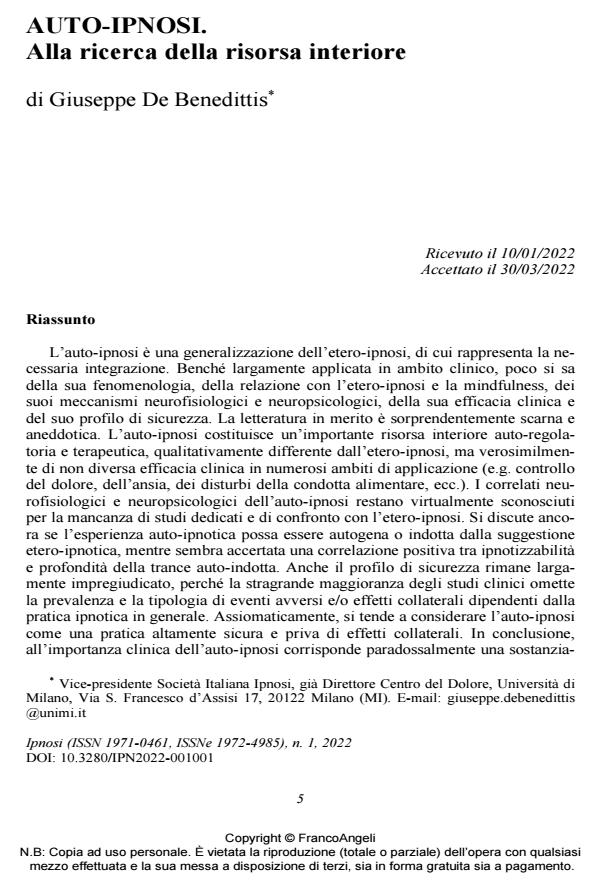AUTO-IPNOSI. Alla ricerca della risorsa interiore
Titolo Rivista IPNOSI
Autori/Curatori Giuseppe De Benedittis
Anno di pubblicazione 2022 Fascicolo 2022/1
Lingua Italiano Numero pagine 16 P. 5-20 Dimensione file 194 KB
DOI 10.3280/IPN2022-001001
Il DOI è il codice a barre della proprietà intellettuale: per saperne di più
clicca qui
Qui sotto puoi vedere in anteprima la prima pagina di questo articolo.
Se questo articolo ti interessa, lo puoi acquistare (e scaricare in formato pdf) seguendo le facili indicazioni per acquistare il download credit. Acquista Download Credits per scaricare questo Articolo in formato PDF

FrancoAngeli è membro della Publishers International Linking Association, Inc (PILA)associazione indipendente e non profit per facilitare (attraverso i servizi tecnologici implementati da CrossRef.org) l’accesso degli studiosi ai contenuti digitali nelle pubblicazioni professionali e scientifiche
L’auto-ipnosi è una generalizzazione dell’etero-ipnosi, di cui rappresenta la necessaria integrazione. Benché largamente applicata in ambito clinico, poco si sa della sua fenomenologia, della relazione con l’etero-ipnosi e la mindfulness, dei suoi meccanismi neurofisiologici e neuropsicologici, della sua efficacia clinica e del suo profilo di sicurezza. La letteratura in merito è sorprendentemente scarna e aneddotica. L’auto-ipnosi costituisce un’importante risorsa interiore auto-regolatoria e terapeutica, qualitativamente differente dall’etero-ipnosi, ma verosimilmente di non diversa efficacia clinica in numerosi ambiti di applicazione (e.g. controllo del dolore, dell’ansia, dei disturbi della condotta alimentare, ecc.). I correlati neurofisiologici e neuropsicologici dell’auto-ipnosi restano virtualmente sconosciuti per la mancanza di studi dedicati e di confronto con l’etero-ipnosi. Si discute ancora se l’esperienza auto-ipnotica possa essere autogena o indotta dalla suggestione etero-ipnotica, mentre sembra accertata una correlazione positiva tra ipnotizzabilità e profondità della trance auto-indotta. Anche il profilo di sicurezza rimane largamente impregiudicato, perché la stragrande maggioranza degli studi clinici omette la prevalenza e la tipologia di eventi avversi e/o effetti collaterali dipendenti dalla pratica ipnotica in generale. Assiomaticamente, si tende a considerare l’auto-ipnosi come una pratica altamente sicura e priva di effetti collaterali. In conclusione, all’importanza clinica dell’auto-ipnosi corrisponde paradossalmente una sostanziale mancanza di studi clinico-sperimentali. L’auto-ipnosi è dunque una Terra Incognita che aspetta urgentemente di essere esplorata.
Parole chiave:Auto-ipnosi, etero-ipnosi, correlati neurofisiologici, mindfulness, tecnica ed efficacia clinica.
- Autoipnosi ericksoniana con uso di toni binaurali e suoni ASMR. Presentazione di un protocollo di somministrazione con case report Claudio Mammini, Nives Manzoni, in IPNOSI 1/2023 pp.23
DOI: 10.3280/IPN2023-001002
Giuseppe De Benedittis, AUTO-IPNOSI. Alla ricerca della risorsa interiore in "IPNOSI" 1/2022, pp 5-20, DOI: 10.3280/IPN2022-001001